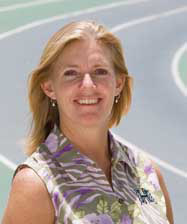Back on Track
September 19th, 2008 | by Jennifer Crites | Published in Sports

Carmyn James
- Web extra Track and field: a brief primer
The year is 2001. The University of Hawaiʻi at Mānoa reactivates women’s track and field after a 16-year hiatus and recruits veteran University of British Columbia Head Coach Carmyn James.
Fast forward seven years. UH heptathlete Annett Wichmann places fourth in the nation at NCAA indoor track and field championships.
“Awesome,” exclaims James. “It’s really hard just to qualify, let alone finish in the top eight and score points.”
The Rainbow Wahine fare even better at the outdoor championships. Three athletes qualify—Wichmann in heptathlon, Amber Kaufman and Emily Sheppard in high jump. All finish in the top six.
“We sent one of the smallest squads and still placed 25th in the country, beating big schools such as UCLA, Alabama and Nebraska. To be at such a high level brought national and international recognition to our program.”
Team members train up to 20 hours a week at Cooke Field. During fall 2008, the old black-rubber infield sprouts new artificial turf, with future renovations transforming the whole complex into a first class facility, thanks to a $5-million gift from the Clarence T. C. Ching Foundation.
“It will look so much more professional,” enthuses James, eager for new hammer and discus practice areas. The track will stay. “We have the only rainbow colored track in the world, and I made it happen!” she adds. “It’s the same surface used at Olympic games and world championships, with cushiony air pockets that return energy so you can run fast times and train safely.”
Cross-country runners often practices off campus—Paradise Park in Mānoa Valley, Magic Island, the hilly slopes of Diamond Head. Their September Big Wave Invitational is on the fairways of the Marine Corps’ Kāneʻohe Clipper Course. “The start line is by the ninth hole,” says James. “By the time golfers get there, we’re finished.”
Most of her student-athletes come from Hawaiʻi and the western U.S.; some apply from Canada, Germany, Australia and elsewhere in hopes of qualifying for one of 18 scholarships. “We have a top high jumper and a discus thrower coming from New Zealand, and all three NCAA finalists from last season are returning,” says James.
When recruiting, she looks at past performance, future potential and GPA. For the last three years the team has achieved All-Academic status; this year two athletes qualified for Olympic trials.
James has set records too. She was the first woman named head coach of a Canadian National Senior team—competing at the 1995 world championships in Sweden. She headed the Canadian University Coaches Association and was on Athletics Canada’s Board of Directors.
Her formula for success: “Follow your heart. Be willing to try something new. And always be the best you can be no matter what the challenge.”
Even if it means overcoming fear of sharks to learn how to surf.
Track and field: a brief primer
Track events: 100M, 200M, 400M, 800M, 1500M, 5000M, 10,000M, 100M hurdles, 3000M steeplechase, 4x100M relay, 4x400M relay. (One lap around the track is 400 meters.)
Field events: high jump, long jump, triple jump, pole vault, shot put, javelin, discus, hammer throw (an eight-pound metal ball at the end of a chain). The heptathlon is a seven-event contest over two days of competition.
Cross country: teams of seven run 5K off-track, usually at a park or golf course.
Scoring: track and field awards points to the top eight finishers in each event, highest tally wins; cross country adds the place for the first five finishers per team, lowest score wins.
Seasons: cross country, Sept–mid-Nov; indoor, Jan–mid-March; outdoor, mid-March–mid-June.
Follow the team: Track and Field or Cross Country for rosters, schedules and results.
Tags: athletics, Rainbow Wahine, track and field, UH Manoa, Vol. 33 No. 3
